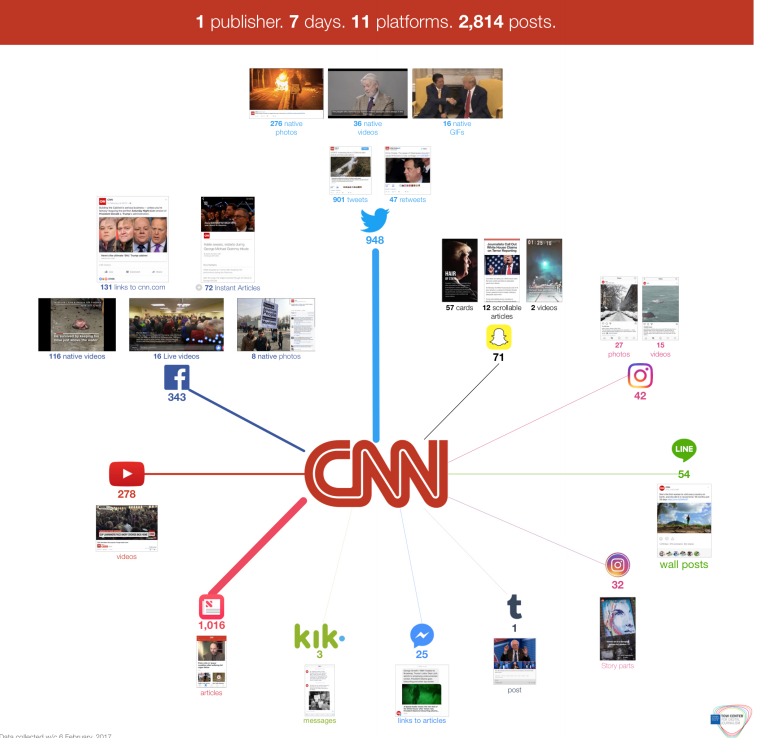Facebook and other platform companies publishing news are forces for bad journalism not good, despite some well-intended efforts lately to help media companies.
That’s the conclusion of a massive, 25,000-word report, “The Platform Press,” published Wednesday by Emily Bell of the Columbia School of Journalism’s Tow Center and co-author Taylor Owen.
The rapid shift to news reading directly on platforms is as big a transformation as digital disruption of print and the shift from desktop to mobile, the authors argue:
These companies have evolved beyond their role as distribution channels, and now control what audiences see and who gets paid for their attention, and even what format and type of journalism flourishes.
While Facebook, YouTube and others are showing concern for the volume of “trashy automated or deliberately made up content” that does well on their sites, the structure of their platforms enables the phenomenon.
The same financial system that incentivizes low quality, sensational, or made-up pages in exactly the same way it incentivizes serious reporting is inevitably going to find itself overrun by the former.
For an example, the authors cite a demonstration by BuzzFeed founder Jonah Peretti and Facebook co-founder Chris Cox at tech conference in San Francisco last year of content that “does well.” Two assistants wrapped more and more rubber bands around a watermelon until it ultimately exploded.
The stunt gathered a Facebook Live simultaneous audience of more than 807,000. How could a serious piece of journalism on issues important to democracy compete with that?
This was presented as a new opportunity for publishers to be enriched by a Facebook innovation. Many in the room likely felt empathy with the watermelon, as their businesses were being squeezed slowly to the point of implosion by external forces beyond their control. One of those forces is Facebook itself.
Some other headline findings:
- Publishers are drawn to publishing directly on social platforms to reach a larger audience, but they lose control of branding, audience data and ad revenue in the process.
- The companies have been unwilling to invest in human editors, favoring algorithm-driven selection. But that’s a cop-out because “the nuances of journalism require editorial judgment.”
- Facebook and the others are far from transparent and accountable about how news is selected and targeted, what data is collected and what online behavior is being encouraged.
The report does not propose a solution to what it summarizes as “the near dominance of Silicon Valley ideology, the pernicious effect of ad-tech economics, and the opacity of automation.”
However the authors suggest four avenues to be explored:
- Vigorous reporting on this “new system of power” even as journalism itself has become embedded in it.
- Create more incentives for good journalism on the social web. This could include government subsidy or funding by the platform companies themselves.
- Revisit how best to edit for quality on the scale of the social platforms with better algorithms and more human input.
- Frame a new generation of public policies to address the problems, possible including antitrust enforcement (as is taking place already in Europe).
Much of the report is spent teasing out the details of how some major news organizations — CNN, The New York Times and The Huffington Post, for example — publish content on various social media platforms. By analyzing thousands of posts and conducting more than 70 interviews, the report shows just how much sway platforms have over how content is produced and published by the press.
The New York Times, for example, made 1,660 posts to nine platforms over a seven-day period in February. CNN published to a wider variety of platforms: 11 over the same seven-day span, with a total of 2,814 posts.

Screenshot, the Tow Center.
The rush to publish on platforms presents news organizations with a dilemma, the report notes. Social media companies are indispensable for newsrooms seeking to maximize their reach and build their audiences. Yet for many, publishing on social media means ceding direct relationships with their audience and giving up monetization opportunities:
Publishers remain confused or undecided about how best to leverage relationships with technology companies. A growing number of news organizations see investing in social platforms as the only prospect for a sustainable future, whether for traffic or for reach. But algorithmic opacity makes it difficult for publishers to plan with certainty. What works now is not guaranteed to work in the future.
This dilemma, and the lack of an overarching sustainable business model within platforms, has already created so-called “news deserts” within mid-sized and small local markets, the report notes. To fix this, platforms could offer publishers some greater financial incentives.
But that could create its own challenges:
If the monetization of material given to social platforms by news organizations does not improve, it will exacerbate the crisis in sustainable journalism at the local and regional level. If the tools and design of platforms do not have civic purposes as well as commercial purpose, this is an inevitability rather than a possibility. However, in the unlikely event platforms do create a really viable economic model for journalism within their own ecosystems, what then? The case for independence becomes more difficult to make on a financial basis, but might still remain a civic concern.
In its conclusion, the report says that regulators will probably not intervene to sort out a solution that works for both news organizations and platforms, leaving leaders at Silicon Valley companies and news executives to sort out their differences. But platforms would hold the balance of power in any such arbitration because they have the economic and cultural upper-hand.
It is necessary that organizations and stakeholders that care about journalism find common cause in addressing not just the specific issues of platform and advertising market design, but also the broader and more enduring issue of what kind of news environment we want.






